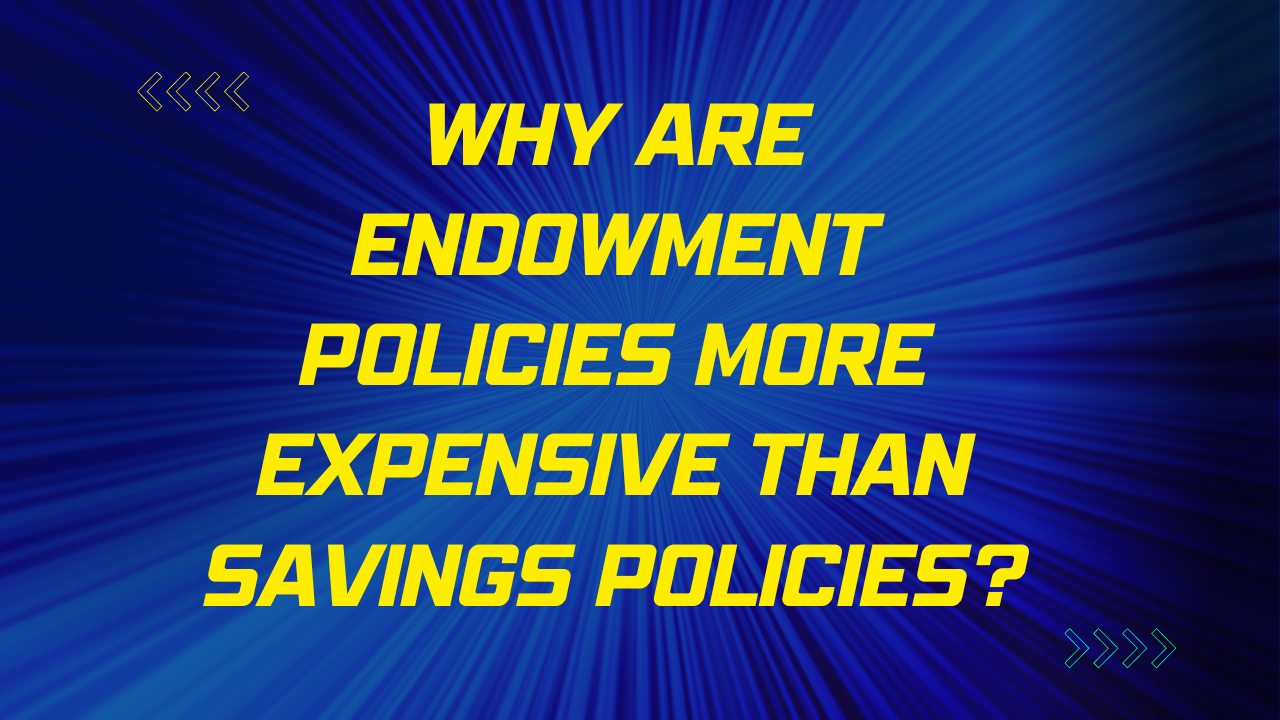Understanding Endowment Policies and Savings Policies
Endowment Policies:
Endowment policies are life insurance plans that offer both insurance coverage and savings or investment components. These policies provide a guaranteed payout to the policyholder either upon the maturity of the policy or in the event of the insured’s demise during the policy term. In essence, endowment policies provide a combination of protection and a savings element, making them an attractive option for those seeking to secure their family’s financial future and build a corpus over time.
Savings Policies:
On the other hand, savings policies are focused primarily on providing a safe and reliable means to save and accumulate funds over a specified period. Unlike endowment policies, savings policies do not offer a life insurance component. Instead, they are designed to help individuals save money regularly and earn interest on their savings, thereby encouraging financial discipline and long-term wealth creation.
Differences in Cost:
The primary reason endowment policies tend to be more expensive than savings policies lies in the inclusion of life insurance coverage. With endowment policies, a portion of the premium goes towards providing life insurance protection to the insured, which adds to the overall cost. This insurance component ensures that in the event of the policyholder’s death during the term, the nominated beneficiary receives a death benefit, providing financial security to the family.
On the other hand, savings policies do not include life insurance coverage, which means that the premiums paid are entirely focused on building the savings corpus. As a result, the premiums for savings policies are generally lower than those of endowment policies.
Factors Influencing the Cost of Insurance Policies:
1. Age of the Insured: Younger individuals typically pay lower premiums since they are considered less risky to insure. As age increases, the risk of health issues and mortality also rises, leading to higher premiums.
2. Health Condition: The health status of the insured plays a crucial role in premium calculation. Those with good health and no pre-existing medical conditions usually receive lower premiums.
3. Lifestyle Habits: Certain lifestyle habits, such as smoking or excessive alcohol consumption, can increase the risk profile of the insured, leading to higher premiums.
4. Coverage Amount: The sum assured or coverage amount selected by the policyholder affects the premium cost. Higher coverage levels result in higher premiums.
5. Policy Type and Term: The type of policy chosen, such as term insurance, endowment, or whole life, and the policy term directly impact the premium calculation.
6. Gender: Statistically, women tend to have longer life expectancies, resulting in lower premiums compared to men.
7. Occupation: Certain occupations are considered riskier than others, affecting the premium amount. Occupations involving hazardous work may lead to higher premiums.
8. Riders and Additional Benefits: Including riders or add-on benefits to the policy, such as critical illness coverage or accidental death benefit, will increase the premium cost.
9. Family Medical History: The presence of hereditary health conditions in the insured’s family may impact the premium amount.
Premium Calculation for Endowment and Savings Policies:
The premium calculation for endowment and savings policies involves various factors, including the insured’s age, health, policy term, and sum assured. Additionally, for endowment policies, a portion of the premium is allocated to the savings or investment component, which affects the overall cost.
Insurance companies use actuarial tables and mathematical models to assess the risk profile of the insured and determine the appropriate premium amount. These calculations consider the probability of claims and expected returns on investments for endowment policies.
In general, endowment policies tend to have higher premiums compared to savings policies due to the inclusion of the life insurance component and the investment element. Savings policies focus solely on accumulating funds, making their premiums relatively lower.
It is essential for individuals to compare different insurance policies, understand their specific coverage needs, and choose a policy that aligns with their financial goals and affordability.
Coverage and Benefits Comparison:
Endowment Policies:
- Endowment policies offer both life insurance coverage and a savings or investment component.
- In case of the insured’s demise during the policy term, the nominated beneficiary receives the death benefit, which includes the sum assured and any accrued bonuses.
- If the policyholder survives the policy term, they receive the maturity benefit, which consists of the sum assured and the accumulated savings component.
Savings Policies:
- Savings policies focus solely on providing a safe and reliable means to accumulate funds over a specified period.
- These policies do not include a life insurance component, so there is no death benefit provided to beneficiaries in the event of the policyholder’s demise.
- The primary objective of savings policies is to promote disciplined savings and earn interest on the savings corpus.
Long-term Savings and Investment Component:
Endowment Policies:
- The savings or investment component in endowment policies allows policyholders to build a corpus over the policy term.
- Premiums paid by policyholders are invested by the insurance company in various investment instruments such as bonds, stocks, and fixed deposits.
- The returns generated from these investments contribute to the growth of the savings component, which enhances the maturity benefit.
Savings Policies:
- Savings policies are specifically designed to foster long-term savings and provide a secure means to accumulate funds.
- The premiums paid by policyholders are deposited into a savings account or investment fund, earning interest or returns over time.
- The accumulated savings in savings policies can be withdrawn by the policyholder at specified intervals or upon maturity, offering liquidity and financial flexibility.
Comparison:
Both endowment policies and savings policies provide avenues for long-term savings. However, endowment policies offer the added advantage of combining life insurance coverage with a savings component, providing financial protection to the family in case of untoward events. On the other hand, savings policies are solely geared towards building a savings corpus without offering any life insurance coverage.
The choice between endowment policies and savings policies depends on an individual’s specific financial goals and priorities. If someone seeks both life insurance protection and long-term savings, an endowment policy may be more suitable. However, for individuals primarily focused on accumulating savings without insurance coverage, a savings policy may better serve their needs.
Ultimately, individuals should carefully assess their financial requirements and consult with insurance professionals to make an informed decision that aligns with their long-term financial objectives.
Additional Features and Riders:
Endowment Policies:
- – Guaranteed Additions: Some endowment policies offer guaranteed additions to the sum assured, enhancing the policy’s maturity benefit.
- – Bonus Accumulation: Policyholders may receive regular bonuses or participate in the insurer’s profits, increasing the overall returns.
- – Partial Withdrawals: Some endowment policies allow partial withdrawals from the savings component in case of urgent financial needs.
- – Premium Waiver: In case of disability or critical illness, the policyholder’s future premiums may be waived while keeping the policy in force.
- – Loan Facility: Endowment policies may allow the policyholder to take a loan against the policy’s cash value.
Savings Policies:
- – Flexible Premiums: Some savings policies offer the flexibility to adjust the premium amount or choose premium payment frequencies.
- – Partial Withdrawals: Policyholders can make partial withdrawals from the savings account without surrendering the policy entirely.
- – Bonus Interest: Certain savings policies offer bonus interest on the savings component, boosting the accumulated funds.
FAQ’s (Frequently Asked Questions):
1. What is the main difference between endowment and savings policies?
Endowment policies include life insurance coverage along with a savings component, while savings policies focus solely on accumulating funds.
2. Can I switch from an endowment policy to a savings policy or vice versa?
Yes, some insurance companies allow policyholders to switch between different types of policies, subject to certain terms and conditions.
3. Are the maturity benefits from endowment policies taxable?
The maturity benefits from endowment policies are tax-exempt under Section 10(10D) of the Income Tax Act, subject to specific conditions.
4. Can I add riders to a savings policy for additional benefits?
No, savings policies do not offer riders as they are primarily designed for savings and do not include life insurance coverage.
Conclusion: Choosing the Right Policy for Your Needs
Selecting the right insurance policy depends on your financial goals, risk appetite, and insurance requirements. If you seek both life insurance protection and long-term savings, an endowment policy with additional features and riders may be suitable. On the other hand, if your primary focus is on building a savings corpus, a savings policy can be a prudent choice.
Before making a decision, carefully assess the coverage, benefits, and flexibility offered by each policy. Evaluate the riders available, considering any specific needs or risks you wish to address. Additionally, compare the premium costs and projected returns to ensure the policy aligns with your budget and financial objectives.
It is advisable to seek guidance from insurance experts and read the policy documents thoroughly before finalizing your choice. Remember that insurance is a long-term commitment, and choosing the right policy tailored to your needs can provide financial security and peace of mind for you and your loved ones.
Read More:
- Post Office Savings Account: Benefits and How to Open an Account
- 7 Simple Ways to Start Saving for a Bright Future
- How can I grow my savings fast?
- Saving Account: Types, Interest rates, and eligibility criteria




